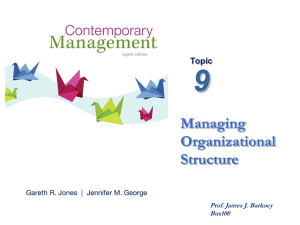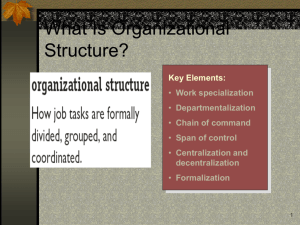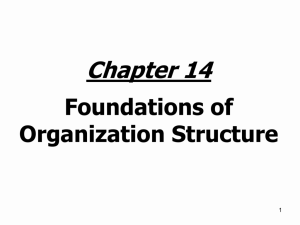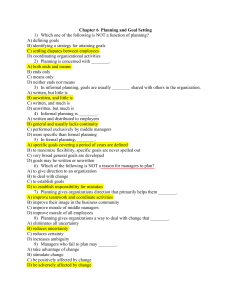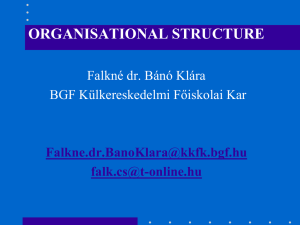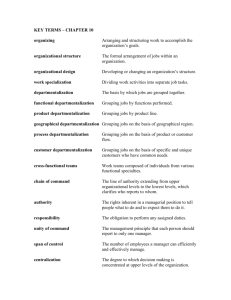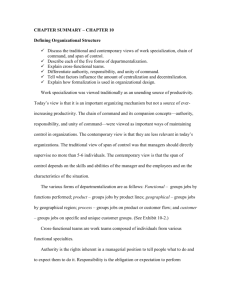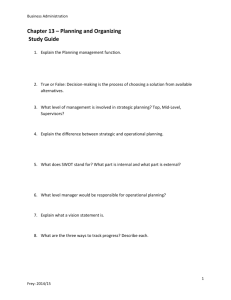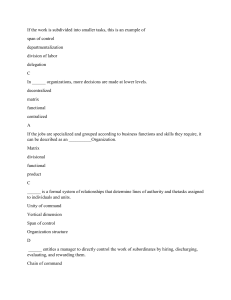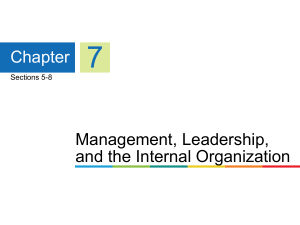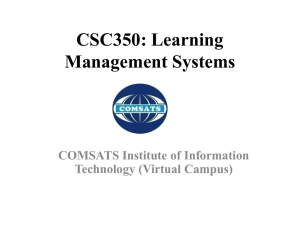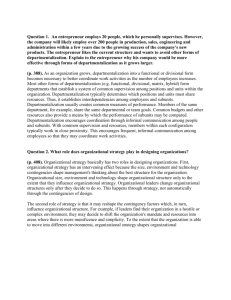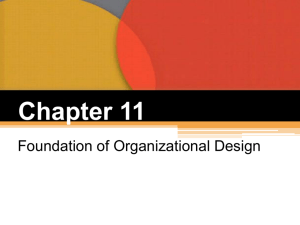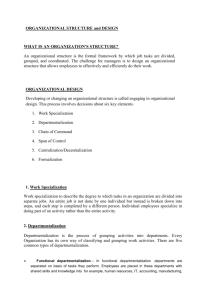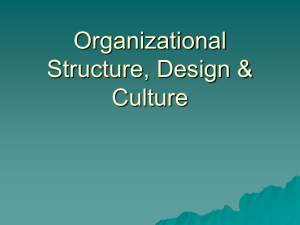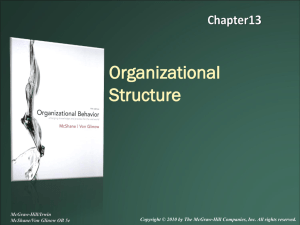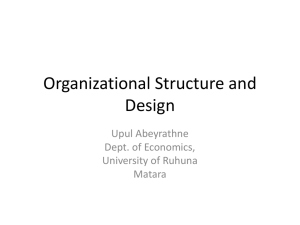Organization - WordPress.com
advertisement
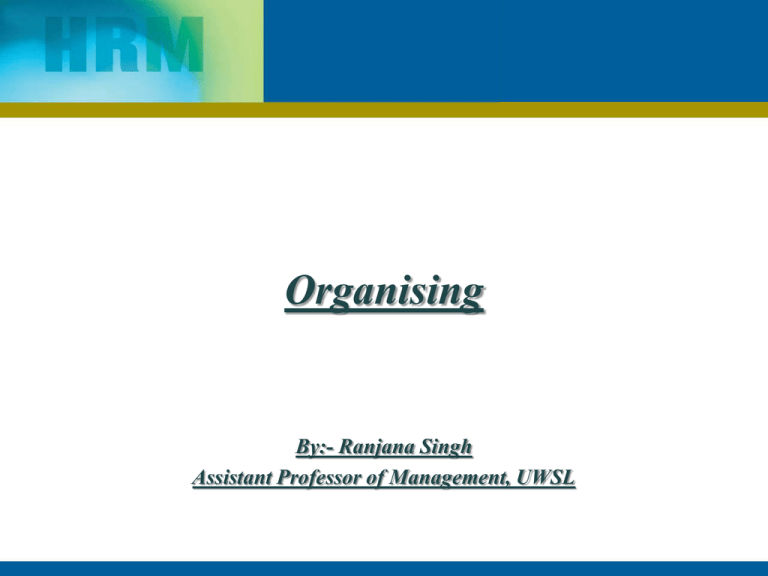
Organising By:- Ranjana Singh Assistant Professor of Management, UWSL Concept of Organisation • "Organisation may be defined as a group of individuals, large of small, that is cooperating under the direction of executive leadership in accomplishment of certain common object.” ~ Keith Davis • “The process of identifying and grouping of the work to be performed, defining and delegating responsibility and authority and establishing relationships for the purpose of enabling people to work most effectively together in accomplishing their objectives.” ~ Louis A. Allen • “organization is the structuring of individuals and functions into productive relationship”. ~ Pfiffner and Presthus Concept of Organisation • The term organisation is used in two senses: 1. Organization as a process 2. Organization as a structure Organizing as a process • Consists of following important steps:1. Determination of objectives 2. Identification of work 3. Grouping of Activities 4. Creation of Managership 5. Division of work within the Departmental Set up 6. Arrangement of Physical Facilities 7. Developing Relations 8. Provision of a channel of communication 9. Coordination of Various Activities. 10. Control and Corrective Action. Principles of Organizing ~ by Ryndall Urwick • • • • • • • Principle of delegation of Authority Principle of Coordination Principle of Continuity Principle of Definition Principle of Explanation Principle of Equilibrium Balance Principle of Flexibility Principles of Organizing ~ by Ryndall Urwick • • • • • • • • • Principle of Unity of Objectives Principle of Responsibility Principle of Specialization Principle of Span of Control Principle of Scalar Chain Principle of Simplicity Principle of Unity of Command Principle of Unity of Direction Principle of Uniformity Principles of Organizing ~ by Ryndall Urwick • • • • Principle of Efficiency Principle of Leadership Principle of Exception Principle of Joint Decision Concept of Organizational Chart • “An organization chart is a diagrammatic form which shows important aspects of an organization, including the major functions & their respective relationship, the channel of supervision & the relative authority of each employee who is in charge of each respective function.” ~ George Terry • It is a snapshot of an organization at a particular point in time which shows the flow of authority, responsibility and communication among various departments which are located at different levels of the hierarchy.” ~ Tripathy & Reddy There are three principal form of “Organization Chart”:~ Vertical Organization ~ Horizontal Organization ~ Circular Organization ~ Tree form of Chart Vertical Chart Horizontal Chart Circular Organizational Chart Tree form of organizational chart Types of Formal Structure Line and Staff Organization Line and Staff Organization Functional Organization Matrix Organization Concept of Departmentalization • “Departmentalization is a process which is used to group activities into units for purposes of administration at all levels.” ~ M.C.Shukla (Business Organization and Management) • “Departmentalization designates a distinct area, division or a branch of an enterprise over which a manager has an authority for the performance of specified activities” ~Koontz & O’Donnell • “Departmentalization is the process in which related functions are grouped into manageable units to achieve the objective of the enterprise in the most efficient and effective manner”. Departmentalization • Common forms of Departmentalization are:1. Functional Organizational Structure (E.g. Finance Department, Marketing Department, HRD Department etc) 2. Product Divisionalization (E.g. Reliance Industries Limited has Several product divisions: Textiles, Polyester, Fibre intermediates, Polymers, Chemicals etc) 3. Geographic Structure (E.g. Tata Global Beverage has adopted geographical structure because the company expanded its activities in a large number of countries. 4. Process Manager (Eg. In a Textile mill Manager Ginning, Manager Spinning, Manager Weaving, Manager Dyeing and Printing 4. Customer Structure (E.g. Industrial Customers & Retail customers of various banks) 5. Time (E.g. Doctors in Hospital, used extensively in public utilities like electricity boards, railways.) Consolidated Organizational Chart Chain of Command • It is the line of authority extending from upper organizational levels to lower levels and clarifies who reports to whom. • Three components decides the chain of command:1. Authority 2. Responsibility 3. Unity of Command Span of Control • It suggests the number of employees that a manager can efficiently manage. • Determines the number of levels in an organization • Traditional view suggests that a manager can not directly supervise more than five or six subordinates. • In recent trend the consideration is given to larger span for:- Speedy managerial Decision making, increase flexibility, get closer to employees, empower employees and reduce costs. Centralization & Decentralization • Centralization is the extent to which the decision making takes place at the upper levels of the Organization. • According to Allen, “Decentralization refers to the systematic effort to delegate to the lowest level of authority except that which can be controlled and exercised at central points”. • Factors which can affect managements decision to centralize or decentralize are:- 1.Cost of decisions 2.Uniformity of Policy 3.Competency Levels 4.Control Mechanisms and 5.Environmental Influences. Formalization/Standardization • Formalization refers to how standardized an organization’s jobs are and the extent to which employee behavior is guided by rules and procedures. • Firms with strong formalization rely on the chain of command for decision making, communication and control. • Although some formalization is necessary for the consistency and control, many organizations, at present, rely less on strict rules and standardization to guide or regulate employee behavior.
